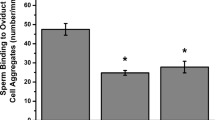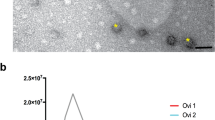Abstract
RECENTLY shed eggs are surrounded by a sticky mass of follicular cells known as the cumulus oophorus. The follicular cells, which are closely attached to the zona pellucida and are arranged in a compact radial pattern, are called the corona radiata. It has been postulated that the follicular cells in the cumulus oophorus can protect the egg against polyspermic fertilization, and can improve the chance of fertilization by providing a large target for the sperm. Further, due to the radial arrangement of the corona radiata, these follicular cells can act in orientating the sperm towards eggs1. After the dissolution of cumulus oophorus by treatment with hyaluronidase in vitro, however, rabbit eggs can be fertilized when transferred into the tubes of mated rabbits2,3. After the dissolution of cumulus oophorus and removal of the corona radiata by manual shaking, the denuded eggs can also be fertilized in vitro4 or in vivo5,6. A comparison of the proportion of eggs fertilized in vitro between denuded eggs and those with follicular cells intact has not been made. In addition, it has been speculated that the progesterone present in the follicular fluid or synthesized by the granulosa cells may be necessary for the “acrosome reaction”, capacitation of sperm, and the fertilization of eggs in vitro7. The experiment described here demonstrates (1) that denuded rabbit eggs lacking follicular cells (or progesterone) can be fertilized equally as well as intact eggs with cumulus oophorus, and (2) that sperm recovered from the vagina can fertilize rabbit eggs in vitro as well as those recovered from the uterus.
This is a preview of subscription content, access via your institution
Access options
Subscribe to this journal
Receive 51 print issues and online access
$199.00 per year
only $3.90 per issue
Buy this article
- Purchase on Springer Link
- Instant access to full article PDF
Prices may be subject to local taxes which are calculated during checkout
Similar content being viewed by others
References
Austin, C. R., The Mammalian Egg, 100 (Blackwell Publications, Oxford, 1961).
Chang, M. C., J. Exp. Zool., 121, 351 (1952).
Dickmann, Z., J. Anat., 98, 392 (1964),
Bedford, J. M., and Chang, M. C., Nature, 193, 898 (1962).
Chang, M. C., and Bedford, J. M., Fert. and Ster., 13, 421 (1962).
Harper, M. J. K., J. Exp. Zool., 173, 47 (1970).
Edwards, R. G., Steptoe, P. C., and Purdy, J. M., Nature, 227, 1304 (1970).
Chang, M. C., Nature, 184, 466 (1959).
Brackett, B. G., Schering Symposium on Mechanisms Involved in Conception, 73 (Pergamon Press, Vieweg, 1970).
Author information
Authors and Affiliations
Rights and permissions
About this article
Cite this article
CHANG, M., HANADA, A. & HUNT, D. Fertilization of Denuded Rabbit Eggs in vitro by Sperm recovered from the Uterus or Vagina. Nature 232, 343–344 (1971). https://doi.org/10.1038/232343a0
Received:
Issue Date:
DOI: https://doi.org/10.1038/232343a0
This article is cited by
-
Hemokinin is a hematopoietic-specific tachykinin that regulates B lymphopoiesis
Nature Immunology (2000)
Comments
By submitting a comment you agree to abide by our Terms and Community Guidelines. If you find something abusive or that does not comply with our terms or guidelines please flag it as inappropriate.



